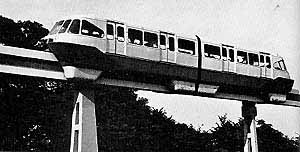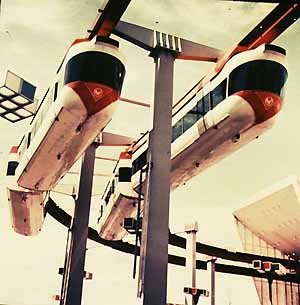Monorails in History - Part II
 |
1952 - ALWEG Monorail Swedish industrialist Dr. Axel Lennart Wenner-Gren was the
first to build a monorail test track after World War II. Wenner-Gren's
first system design was geared more towards a high-speed city
to city rail system. Seen here is the scaled-down train which
attained speeds near 160 km on an oval test track in Fuhlingen,
Germany. While impressive in speed and banking capabilities,
the ALWEG system didn't find its niche until a later version
was developed and unveiled in 1957 (see below). |
|
 |
1956- Skyway Monorail Monorail, Incorporated built a short test track of their suspended
system at Arrowhead Park in Houston, Texas. Each bogie was powered
by a 310-horsepower Packard automobile engine. The driver was
seated high above the passenger carriage on one of the two bogies.
After eight months of testing, the track was dismantled and rebuilt
at the Texas State fairgrounds where it ran for many years. Its
promoters claimed it could reach speeds of 160 km but no Skyway
transit installations were ever built. |
|
 |
1957 - Ueno Zoo Japan in the 1950's was in an all-out effort to improve its
transportation systems. The first Japanese monorail debuted at
Tokyo's Ueno Zoo in 1957. Basically a modern version of Wuppertal's
system, the Ueno line used off-the-shelf parts including rubber
tires. Japan would later adopt the Alweg and Safege monorail
systems and build more transit monorails than any other country
in the world. |
|
 |
1957 - ALWEG Monorail Based on knowledge gained from the original test track of
1952 and subsequent modifications, ALWEG unveiled what has become
the most successful monorail system in July of 1957. Located
at the same Fuhlingen test sight, this was ALWEG's first full-scale
monorail. It caught the attention of Walt Disney, which resulted
in the world's attention to the design after Disneyland opened
their ALWEG monorail in 1959. Today ALWEG-based systems exist
all around the world and many more are in the works. |
|
 |
1958 - SAFEGE Monorail In 1947, the eminent French bridge builder Lucien Chadenson became interested in the Bennie Railplane experimental line. Also impressed by the Paris Metro Route 11, which uses rubber tires, he decided to combine the two principles. The result was a suspended monorail in which the bogies are protected from weather conditions inside a steel or concrete box-beam above the train. The test track operated for many years in Chateauneuf, south of Paris. Film buffs may recognize it from the sixties classic "Fahrenheit 451." Curiously, the French have never used the system, but the Japanese have built two successful Safege lines (see Monorails of the World page).
The Siemens Company of Germany has developed a smaller scale
system similar to the SAFEGE Monorail. Aerorail of Texas and
Sky Train of Florida are promoting steel-wheel versions of SAFEGE
as well. |
|
 |
1959 - Disneyland/Alweg Monorail No monorail in history captured the attention of the public
quite like Walt Disney's Alweg Monorail did when it opened in
1959. The result would be the unfortunate type-casting of monorails
being "theme park rides," except in Japan. Later versions
of the Disneyland monorail improved on the Alweg system and in
1971 a larger dual-rail system was built in Florida at Walt Disney
World. A full-sized Alweg monorail was also built for the Tokyo
Disneyland Resort area in the 1990s. |
|
 |
1961 - Turin, Italy In July 2, 1961, TMS member Albert G. Nymeyer
took this picture of the first full scale non-test track Alweg
line. It ran at Italia 61, which celebrated Italy's national
centenary. Over one and a half million passengers traveled on
the line for the short period of the fair. Plans to operate the
monorail on a permanent basis and extend it to Moncalieri never
came to fruition. |
|
 |
1962 - Seattle The first dual-rail Alweg line opened for the 1962 World's Fair in Seattle. It remains there today. In the 1990s and early 2000s Seattle voters supported an expanded monorail system for the city four times. The project was cancelled in 2005 after the Mayor and Council withdrew support and financing became controversial. |
|
|
|
1962 - Nihon/Lockheed Monorail This unique system was invented in the USA and built at a
test track in Gifu, Japan. While actually being selected for
both Seattle and Tokyo, Alweg later won out for those milestone
monorails. The Lockheed design is similar to Alweg in that it
uses a concrete beam, but the track and wheels are steel. Two
were built for transportation in Japan, yet they no longer operate. |
|
 |
1964-1965 AMF New York World's Fair In an effort to promote their Safege licensed monorail, AMF
installed and operated a one-station I-Beam monorail for the
two-year New York World's Fair. The dual-rail system looped around
the amusement area. An earlier Disney monorail plan to surround
the entire fairgrounds was rejected, probably due to a much higher
price tag. While AMF never sold or built any Safege Monorails,
this installation was responsible for many of today's enthusiasts
first ride on monorail. See our Links Page
to get to a terrific website on this monorail. |
|
 |
1964 - Tokyo/Haneda Monorail We've chosen to end our history section on the monorail that
began the modern era of transit monorails. The Tokyo/Haneda Monorail
was the first major system to incorporate the Alweg design and
use switches for direction reversal. It continues to operate
safely and at a profit today. More information on the Tokyo Monorail
(with pictures of current trains) can be found in the Where
Are They section. |